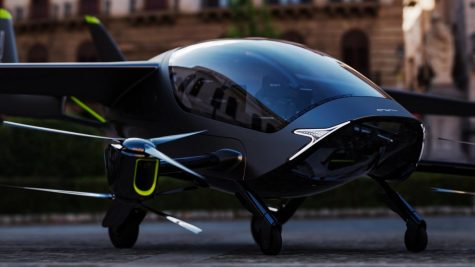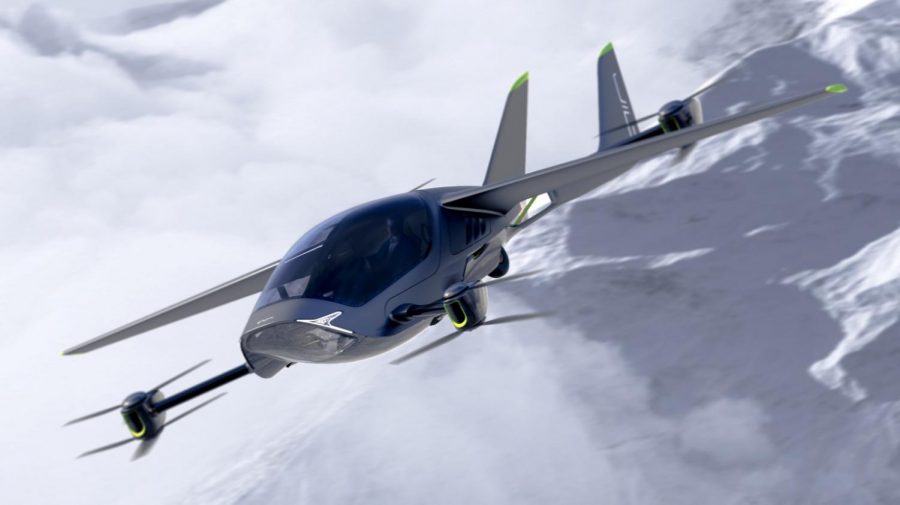Commute got you down? Fly to work on your electric plane
An Israeli startup has developed a personal electric plane, that can take off and land vertically. It’s already taking pre-orders.
Published October 21, 2021
(ISRAEL21c) – The morning news is reporting terrible traffic into the city. Waze has no workaround, and you’re needed in the office for an important client meeting at 9am sharp.
“No problem,” you smile. “I’ll just fly to work.”
Literally.
That’s the promise of the AIR ONE from Israeli startup AIR, which began taking pre-orders this week for its eVTOL – electric vertical takeoff and landing car.
That’s right: pre-orders for a personal flying car.
Most other eVTOL makers, like fellow Israeli flying carmaker Urban Aeronautics, have targeted more commercial functionality, such as emergency medical response, for their initial deployments.
eVTOL is the technical term for what mobility fans have been anticipating since the early 1960s, when TV’s George Jetson commuted to his animated push-button job at Spacely Sprockets.
This is a flying car powered by the same batteries used in today’s electric cars. It will charge from the same infrastructure used for the Chevy Bolt or electric Ford F-150. In contrast, Urban Aeronautics’ CityHawk will be powered by hydrogen fuel cells.
AIR’s big reveal follows four years of development. The company’s initial model will be a two-seater that can fly for 110 miles at 155 miles an hour. Early adopters can plunk down a symbolic fee to be first in line when AIR ONE is released.
Becoming an eVTOL pilot
Unfortunately, a working vehicle isn’t expected to be ready until 2024. So why announce now when the reality is still a few years away?

“We wanted to prove that it’s doable,” AIR CEO and cofounder Rani Plaut tells ISRAEL21c.
“And we wanted to start a relationship with customers now, to look for feedback. The pre-orders are not as much for the money but for proving that there is a viable market out there. The big hurdle is more about adoption and less about regulation.”
By regulation, Plaut is referring to rules by aviation authorities such as the FAA in the United States that determine where an eVTOL can fly and what licensing will be required.
“There are several levels of pilot licenses,” Plaut explains. “We would like the lower level and we’re working with the FAA to approve it.”
The lower-level licensing Plaut is seeking is more like getting a driver’s license than a traditional pilot’s certification, requiring just 15 hours of practice and five hours of solo flying. The cost for this kind of training, Plaut says, is a few thousand dollars.
Fly-by-intent
AIR ONE’s software and hardware are designed to make flying as simple as driving a car.
“Most aircraft use ‘fly-by-wire,’” Plaut explains. That’s where there is a mechanical connection between, say, the vehicle’s “steering wheel” and the wings and rotors.
AIR One uses what Plaut calls “fly-by-intent.” All the navigation is done by sending digital signals to the motor controllers and other elements. There’s no mechanical connection.

Going digital also allows AIR to build in some serious smarts. “We’re designing the left-hand turn in the best way possible,” Plaut says, “a designed and fabricated perfect left turn, the way the best pilot would have done it.”
Is that artificial intelligence? ISRAEL21c asked Plaut.
“It’s the opposite,” he answers. “AI goes up the scale in complexity. We’re going the other way. Our core components keep the aircraft stable and in the right position. This simplifies a lot of functions and allows the craft to make the perfect left-hand turn based on innate, reflex-based functions.”
Still, even with the smartest software there will be safety concerns taking to the air.
“People asked the same question in the 1920s about cars,” Plaut observes. “In London, at the turn of the century, if you owned a car, you needed to have a person walking in front!”
Plaut has a simple answer for what will make the difference: “Time.”
Going to the third dimension
There’s no lack of competition in the eVTOL space – from single-person hobbyist crafts to sophisticated $4 million air taxis – interest is growing fast.
Even Elon Musk wants to get in on the action, and has said he is ‘dying’ to build a supersonic electric jet.
Closer to home, in June 2019, Israeli company Eviation Aircraft announced it’s new electric commuter plane, Alice, at the Paris Air Show. A few months later, the company was acquired by Clermont Aerospace.
Plaut isn’t too worried. He believes that every new eVTOL “will contribute to people feeling comfortable about going into the third dimension” – the sky.
To put your mind somewhat at ease, AIR ONE has a built-in parachute so that, if there is a disaster in the air, you’ll reach the ground safely.
Beyond the software, AIR’s other big innovation is about scale. Other flying-car makers can produce 20, 50, maybe even 100 craft a year because the process is mostly handcrafted, Plaut says, unlike automated car production.
“Our aircraft are designed to automotive-level production quality,” Plaut says. AIR aims to manufacture tens of thousands of its flying cars every year.
Secret superpower
AIR was founded by Chen Rosen, a long-time aviation and UAV enthusiast, in part to address road congestion by moving some of the daily commute into the air, Plaut says.
Yet initial users will probably not be city-dwellers.
“I prefer the first customers to use it in rural areas or to land at the edge of the city and take an Uber in to work,” Plaut notes. “You could use it to go sightseeing or on a picnic with friends.”
AIR ONE, with its 150-mile range, is not suitable for a vacation jaunt from Tel Aviv to Eilat and back… at least not yet, although range and functionality will undoubtedly improve.
Parking is another reason AIR ONE may not be applicable for urban environments. “The vehicle is large,” Plaut admits, like two cars parked with a substantial amount of space between them.
However, AIR ONE has a secret superpower: It is foldable. When folded, it will measure about the size of a single Ford F-150 pickup truck.
The vehicle has collapsible landing gear and power wheels to get into a tight spot. “You can’t drive it on the road; it’s too slow,” Plaut stresses, but it is drivable.
“If we lower the bar and don’t fly into cities or over congested areas in the beginning, then the question is: Are you willing to spend your money on a vehicle that costs the same as a car and will you trust my technology to take you from point A to B?” Plaut asks.
“The future of mobility is in the sky, but to get there we need to build consumer confidence in eVTOLs as a legitimate mode of everyday transport and develop vehicles on a mass-scale to bring that vision to life.”
Personal transportation
Plaut contrasts AIR ONE with building a complete air taxi system, “which is more like a mini-airport. You need commercial pilots, operators, landing spaces.”
Going the more personal route allows AIR to gauge the market before scaling up.
“The essence of the company is to have something resembling a Tesla,” he says. Indeed, Plaut anticipates selling AIR ONE direct to consumers via showrooms, ala Tesla.
Keeping with the Tesla analogy, Plaut notes that “the first Teslas didn’t go more than 170 miles.” But even 100 miles of range covers “enough of your life for most tasks including commuting.”
AIR ONE’s price will be similar to the cost of a Tesla Model S, Plaut adds.
As for the pre-order fee, Plaut says that the company will work with each customer on a case-by-case basis. “We want some level of commitment, but it will be a small amount.”
The company’s vision is “to make something as easy as a car with a practical range and a practical price. If we can do that, I think we can make a real difference.”
Future is in the sky
It’s still very early days for personal flying cars (“There are over 80 million cars sold a year. We are at zero,” notes Plaut) and there’s plenty of infrastructure to build – not lanes in the clouds or exit ramps off the skyway, but rather software limiting where the aircraft can go.
“Flying cars are [already] a reality. The aviation technology exists, and early-stage regulatory review is underway in both the U.S. House and the Senate to bring eVTOLs to market,” writes Nimrod Golan-Yanay in TechCrunch.
“What doesn’t exist is a place to land them. Decades from now, city infrastructure will look very different. ‘Vertiports’ within the city that can accommodate eVTOLs of all sizes and distance capabilities will be commonplace in the modern metropolis.”
At which point, a near-future George Jetson might call out, upon arrival from his personal AIR ONE flying car, “Jane, I’m home!”
For more information, click here.















